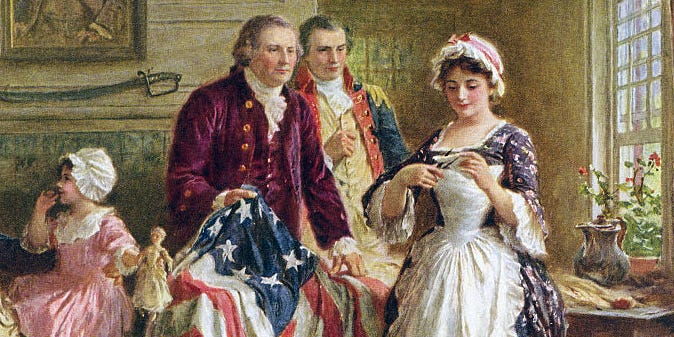The American flag, a powerful symbol of freedom and unity, has flown proudly for centuries. Its stars and stripes evoke feelings of patriotism and national pride, reminding us of the sacrifices made To Secure Our Liberties. But have you ever wondered about its origins? Who stitched together those iconic red, white, and blue colors? The answer, Like Many Historical Mysteries, is not always straightforward.
While the tale of Betsy Ross sewing the first American flag has Been Passed Down Through Generations, recent scholarship suggests a different story. Who designed the first American flag? While Betsy Ross remains a popular figure in American lore, historians now point to Francis Hopkinson, a Founding Father and signer of the Declaration of Independence, as a more likely candidate.
Hopkinson’s claim rests on compelling evidence, including a letter he penned requesting payment for designing the flag and entries in Continental Congress journals that Mention His Involvement. Despite these claims, Hopkinson’s requests for compensation were repeatedly denied due to the young government’s financial constraints and differing opinions on His Sole Authorship.
The Betsy Ross Legend
The story of Betsy Ross sewing the first American flag gained widespread Popularity Much Later, primarily through family accounts and artistic Representations Passed Down Over Time. These narratives often depicted a charming scene of Betsy, a skilled seamstress, carefully crafting the flag in her Philadelphia home at the request of General George Washington himself. This romantic image resonated with the Public Imagination, solidifying Betsy Ross’s place in American folklore.
The rise of the Betsy Ross legend coincides with several historical shifts. The late 19th century saw a growing interest in celebrating American history and heroes, particularly during the centennial celebrations of the nation’s independence. Additionally, the burgeoning women’s suffrage movement sought to elevate the contributions of women in society, and the story of Betsy Ross as a pioneering female artisan fit neatly into this narrative.
The symbol of the flag itself also gained renewed importance after The Civil War. It became a powerful representation of national unity and reconciliation, further cementing the connection between Betsy Ross’s story and the American identity. While historical evidence points to Francis Hopkinson as the more likely designer, the enduring legacy of Betsy Ross speaks to the power of storytelling and its ability to shape our understanding of history.
Francis Hopkinson’s Claim
Francis Hopkinson, a signer of the Declaration of Independence and a prominent figure in early American politics, firmly believed he was the creator of the first American flag. He wasn’t shy about voicing his claim, even going so far as to write a letter to the Continental Congress requesting compensation for his design work.
Hopkinson’s argument rested on his expertise in design and his active role in The Continental Congress during the period when the flag was conceived. He meticulously outlined his contributions, asserting that he had personally designed the flag based on the principles of liberty and unity it represented. Furthermore, entries in The Continental Congress journals mention Hopkinson’s involvement in discussions regarding the creation of a national flag, Lending Credence To His Claim.
Despite his compelling arguments and supporting evidence, Hopkinson’s requests for payment were repeatedly denied. The young government faced financial constraints, and there was disagreement among members regarding whether Hopkinson deserved sole authorship credit. This rejection ultimately cast a shadow over Hopkinson’s legacy and allowed the Betsy Ross story to gain traction in later years.
 Cult Leaders America: Infamous Figures & Their Cults
Cult Leaders America: Infamous Figures & Their CultsEvidence for Hopkinson’s Design
While the Betsy Ross story has Captivated Generations, historical evidence supporting Francis Hopkinson’s claim as the designer of the first American flag is surprisingly strong. One key piece of evidence is a letter Hopkinson wrote to The Continental Congress in 1782. In this letter, he boldly asserted his role in designing the flag and formally requested compensation for his work.
Adding weight to his claim are entries found within the Continental Congress journals from that same period. These records mention Hopkinson’s active participation in discussions surrounding the creation of a national flag, suggesting he was deeply involved in the design process. While these entries don’T Explicitly State who created the first flag, they certainly place Hopkinson at the heart of those crucial conversations.
Though his requests for payment were ultimately denied due to financial constraints and differing opinions on authorship, Hopkinson’s letter and documented involvement in Congress discussions provide compelling evidence that he was a key figure in the birth of the American flag.
The Rise of the Betsy Ross Narrative
The story of Betsy Ross sewing the first American flag didn’t gain widespread recognition until much later, primarily in the 19th century. This surge in popularity can be Attributed To Several Factors. First, there was a growing nationalistic sentiment in America during this period, with a desire to celebrate its history and heroes. The story of Betsy Ross, a skilled seamstress who patriotically crafted the symbol of freedom, resonated deeply with this sentiment.
Furthermore, the rise of the women’s suffrage movement in the late 19th century played a role in elevating the status of women like Betsy Ross. Her story provided a compelling example of a woman making a significant contribution to American history, inspiring generations of women seeking equality and recognition. The narrative also gained momentum through Artistic Representations, such as paintings and sculptures, that depicted Betsy Ross sewing the flag with meticulous detail, further solidifying her place in the Public Imagination.
The enduring legacy of the Betsy Ross story highlights the power of storytelling and its ability to shape our understanding of history, even when evidence suggests a different truth. Despite historical inconsistencies, who designed the first American flag remains a topic of debate and fascination for many Americans.
Symbolism and Legacy
The American flag, regardless of its exact origins, has become a powerful symbol of freedom, unity, and national pride. Its red stripes represent valor and hardiness, while the white stripes symbolize purity and innocence. The thirteen stars, originally representing the original thirteen colonies, now stand for all fifty states, showcasing the nation’s growth and evolution.
The flag’s enduring legacy is evident in its ubiquitous presence throughout American society. It waves proudly over government buildings, schools, businesses, and homes, serving as a constant reminder of shared values and national identity. It has also become a symbol of hope and resilience, particularly during times of crisis or National Challenge.
The story of the American flag’s creation, whether attributed to Betsy Ross or Francis Hopkinson, continues to captivate and inspire generations. It serves as a testament to the enduring power of symbols and their ability to unite and represent a nation’s aspirations.
More for curious minds
Unlock extra content and exclusive deals tailored to your interests.










